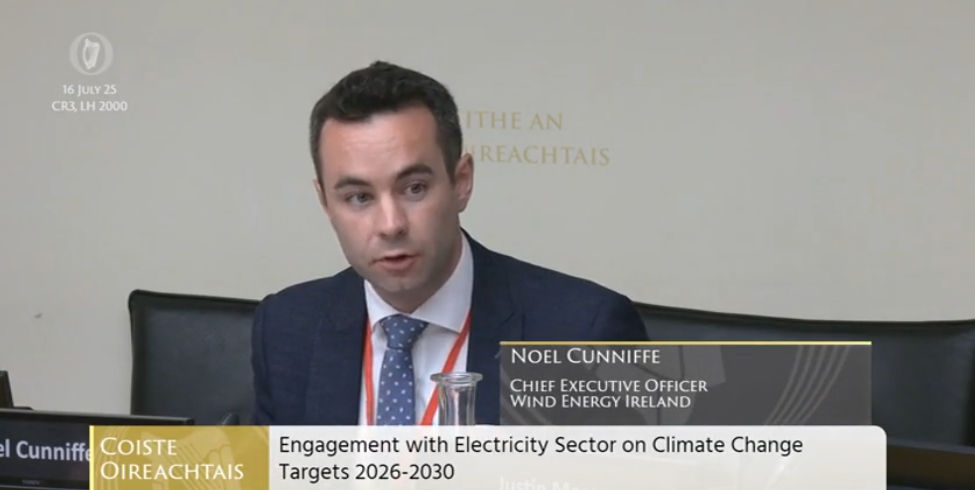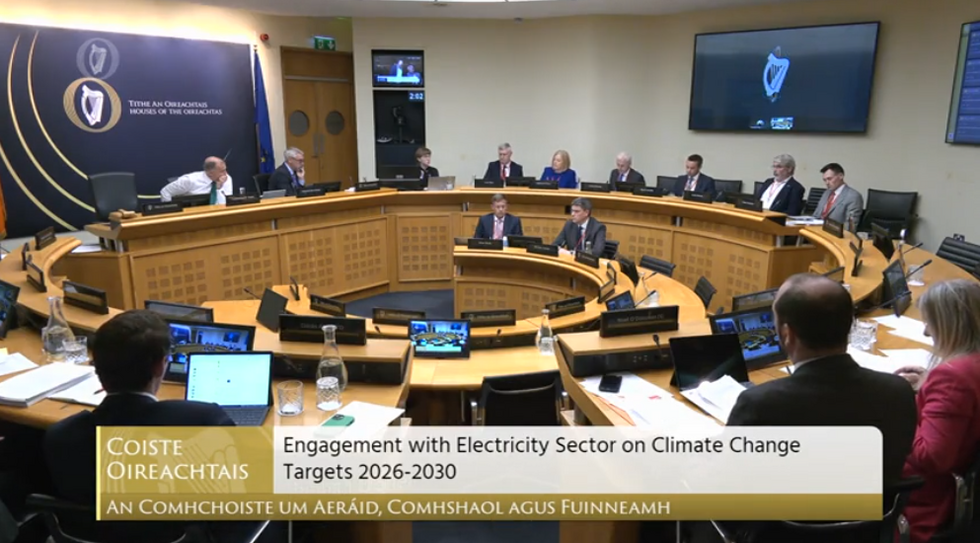Wind Energy Ireland Opening Statement to the Joint Oireachtas Committee on Climate, Environment and Energy
17 Jul 2025
On Wednesday 16 July, a Wind Energy Ireland delegation led by CEO, Noel Cunniffe, Director of External Affairs, Justin Moran, and Head of Policy and Research, Dave Linehan, presented to the Joint Oireachtas Committee on Climate, Environment and Energy on the topic of climate change targets for the electricity sector 2026-2030.
A copy of the WEI Opening Statement is below and you can watch the full committee meeting here.

Introduction
Cathaoirleach, members of the Committee, thank you for the opportunity to appear before you today to represent the views of our more than 200 member companies.
I am joined today by our head of policy and research, Dave Linehan, and our director of external affairs, Justin Moran.
Benefits of wind energy
Wind energy has become Ireland’s leading source of renewable electricity – last year Irish wind farms provided 32 per cent of the country’s electricity – and no country in Europe gets a larger share of their power from onshore wind farms than we do.
Yet every hour, Ireland is spending €1 million to import fossil fuels when there is a viable alternative, a way to keep this money at home.
Our wind farms strengthen Irish energy security.
In the past three years, Irish wind farms cut spending on imported fossil fuels by €3.3 billion and saved almost €1 billion more in carbon credits, while displacing almost 7 billion cubic metres of fossil fuel gas.
Our wind farms protect Irish electricity consumers.
Research published this year demonstrates that since 2000, renewable electricity has – conservatively – saved consumers nearly €1 billion.
Between 2020 and 2023 alone, at the height of the energy crisis and the COVID-19 pandemic, renewable electricity cut bills by an average of €320 per person.
The next five years are an opportunity to make unprecedented progress in moving our nation to rely on locally produced renewable energy and accelerate the next phase of Ireland’s economic development.
Onshore wind energy
To achieve this we must first accelerate the delivery of Ireland’s most affordable source of new electricity, onshore wind farms.
In the first study of its kind, a report published this year by planning consultancy MKO, analyses Ireland’s geography, examining the land available in the country for future development.
It identified roughly thirteen hundred square kilometres on which new wind farms could be built – less than 2 per cent of the Republic of Ireland. Conservative estimates suggest this could produce nearly 6,000 MW of additional onshore wind energy beyond our 9,000MW target for 2030.
Delivering this power, which is possible by delivering our existing pipeline and developing the land identified in this research, will drive down electricity costs for Irish families and businesses.
We are calling on the Government to set new targets for onshore wind energy of 11,000 MW by 2035 and 15,000 MW by 2040 and we would ask for the committee’s support.
Offshore wind energy
Looking beyond our shores, offshore wind energy can complete our country’s quest for energy independence and economic prosperity.
In May we launched our Offshore Wind Action Plan.
It sets out the clear and practical Government actions to support the delivery of offshore wind projects through 24 targeted actions, split across four delivery areas.
These areas are:
- Delivering the Phase One projects to establish Ireland’s offshore wind industry. This is an essential first step.
- Maximising the South Coast Designated Maritime Area Plan (DMAP), by progressing the Tonn Nua site auction later this year and developing the three other sites in the DMAP.
- Accelerating the National ORE DMAP to provide a long-term pipeline of projects for both fixed and floating wind.
- Building vital infrastructure and coordinated electricity demand strategies, which includes investment in ports, grid capacity and new industries which can both support and benefit from offshore wind growth.
Among the recommendations are the urgent resourcing of planning authorities and key State agencies, clarity on future grid access and offshore auctions and enabling the necessary investment in our ports to ensure Irish offshore wind farms are constructed at home, benefiting our coastal communities.
The actions laid out in the plan will help to remove barriers to the delivery of clean, affordable, offshore energy and we look forward to discussing them with the committee.
Grid infrastructure
Last year, Ireland set a new record for installed wind energy generation, with over 5,000 MW of onshore wind now providing power.
But it was also the worst year on record for wasted wind power with recent research estimating the cost to consumers of this waste has risen from €90 million in 2016 to €450 million last year.
Despite the best efforts of our colleagues here today in EirGrid and ESB Networks our electricity grid is simply not able to cope with what our members produce today, let alone meet future demands from offshore wind, solar generation and the electrification of our economy.
Every time a wind turbine is shut down because the grid cannot take the electricity, it means higher bills and more carbon emissions.
I would ask the committee to support calls for continued investment in our energy infrastructure – to increase grid capacity and energy storage – and to publicly back proposed grid infrastructure projects.
If we fail to support and deliver grid, we will fail to grow our economy, put our electricity supply at risk and effectively abandon our legal climate obligations.
Conclusion
At a time when our economy is under threat from tariffs, energy costs and global uncertainty we have a solution here in Ireland.
To develop this enormous potential we need evidence-based new wind energy guidelines and a well-resourced planning system, which prioritises renewable energy and takes full advantage of changes in EU law designed to accelerate the development of wind power.
Supporting this we must have a stronger electricity grid which ensures the clean, affordable, power from these wind farms gets to those who need it. Building that grid means delivering essential upgrades and new power lines, like the North-South Interconnector, which is the spine around which we can build an electricity grid for a 21st century economy.
The challenge is significant, but the reward is a clean, affordable, energy-secure future, that supports Irish jobs and communities.
That’s a future, and a country, worth investing in.







